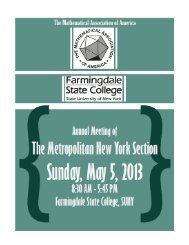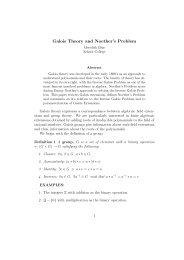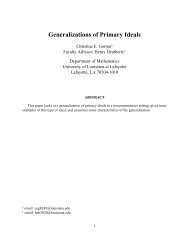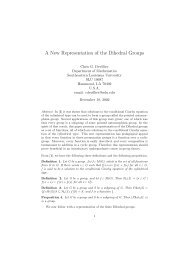Abstracts and Biographical Information - Sections - Mathematical ...
Abstracts and Biographical Information - Sections - Mathematical ...
Abstracts and Biographical Information - Sections - Mathematical ...
Create successful ePaper yourself
Turn your PDF publications into a flip-book with our unique Google optimized e-Paper software.
KYMAA Spring 2012<br />
Bellarmine University, Louisville<br />
Friday, March 30- Saturday, March 31, 2012<br />
Chris Christensen (f), Northern Kentucky University<br />
Fruit Attack<br />
JN-25, the primary Japanese naval code of World War II, used additives. British <strong>and</strong> American<br />
codebreakers tried to separate the additives from the code groups first by h<strong>and</strong> <strong>and</strong> then by machine<br />
(<strong>and</strong> then went back to “by h<strong>and</strong>”). One of the machines used to attack JN-25 was built at National<br />
Cash Register in Dayton, Ohio. Because of its appearance, the British called the machine “Fruit.”<br />
We will consider how Fruit operated <strong>and</strong> how it was used to attack JN-25.<br />
Tyler Clark (g), Western Kentucky University<br />
Continued Radicals <strong>and</strong> Cantor Sets<br />
We will construct several continued radicals <strong>and</strong> look at their convergence properties. Furthermore,<br />
we will look at some conditions in which a continued radical creates a set homeomorphic to the<br />
cantor set. Finally, we will examine the measure of the generated Cantor sets.<br />
Tarah Cole (u), Northern Kentucky University<br />
Assessment of Risk Factors for Truancy of Children in Grades K-12 Using Survival Analysis<br />
Survival Analysis is a time-to-event statistical analysis commonly used to assess risk of particular<br />
events based on available predictors. This presentation provides a brief overview of survival<br />
analysis, primarily focusing on the methodologies <strong>and</strong> results from a study conducted to evaluate<br />
risk factors pertaining to truancy using data obtained from a large Kentucky school district.<br />
D. Coulliette (f), K. Rietz (f), <strong>and</strong> N. Brabon (u), Asbury University<br />
Rate-Limited Sorption Modeling in Contaminant Transport<br />
Computational models of contaminant transport are used regularly for designing subsurface<br />
environmental remediation systems. These models predict the movement of the contaminant<br />
„plume‟ through a porous media containing groundwater. In many soils, the contaminant sorbs to<br />
the solid matrix in the porous media. As a result, the rate at which this contaminant may be removed<br />
by traditional pump-<strong>and</strong>-treat flushing is much slower than that of the contaminant in the fluid<br />
portion of the media. This phenomenon is called rate-limited sorption (RLS) <strong>and</strong> it is particularly<br />
problematic in cases where the contaminant has been in place for a long period of time. Although<br />
RLS has been noted in the academic literature for years, production models used for field work have<br />
failed to incorporate the issue. This work presents preliminary results of an attempt to model RLS in<br />
a production contaminant transport code.<br />
Daniel J. Curtin (f), Northern Kentucky University<br />
The History of the KYMAA<br />
The national MAA was founded in 1915. In 1916 the Mathematics Section of the Association of<br />
Kentucky Colleges <strong>and</strong> Universities, founded in 1909, applied for membership. In 1917 it became<br />
the Kentucky Section of the MAA. In 2015 the MAA celebrates its centennial, <strong>and</strong> in 2017 we<br />
celebrate ours. A history of the MAA, including histories of the sections is in the works. This talk is<br />
a preliminary report in which I will discuss the founding of KYMAA, the role of private <strong>and</strong> public<br />
institutions <strong>and</strong> the early role of women in both leadership <strong>and</strong> the scholarly program. I will also<br />
touch on Dick Davitt‟s work on Jewish mathematicians fleeing the Nazi regime who were welcomed<br />
into Kentucky.<br />
6

















